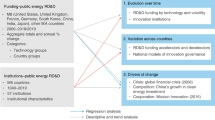Abstract
Governments are increasingly relying on directed development tools or proactive public-policy approaches to stimulate scientific and economic development for their biotechnology industries. This article will discuss the four main tools of directed development in biotechnology and the lessons learned from current global efforts utilizing these tools.
This is a preview of subscription content, access via your institution
Access options
Subscribe to this journal
Receive 12 print issues and online access
$209.00 per year
only $17.42 per issue
Buy this article
- Purchase on Springer Link
- Instant access to full article PDF
Prices may be subject to local taxes which are calculated during checkout



Similar content being viewed by others
References
Clark, H. Prime Minister's Statement to Parliament [online], <www.executive.govt.nz/minister/clark/innovate/speech.htm> (2002).
New Zealand Government. Ministry of Economic Development. Growth through Innovation: Progress to Date [online], <http://gif.med.govt.nz/aboutgif/indicators-2005/progress/> (2005).
Falconer, B. et al. Growing the Biotechnology Sector in New Zealand: A Framework For Action (Biotechnology Taskforce, Wellington, New Zealand, 2003).
Beckman, R. & Goldberg, A. Bold Steps-New Horizons: An External View of New Zealand Biotechnology and its Future in the Global Arena [online], <http://www.biospherenz.com/download/external-view-nz-biotech.pdf> (2003).
US Department of Commerce Technology Administration. A Survey of the Use of Biotechnology in US Industry [online], <http://www.technology.gov/reports/Biotechnology/CD120a_0310.pdf> (2003).
DeVol, R. et al. Biopharmaceutical Industry Contributions to State and US Economics (Milken Institute, California, 2004).
Fasol, G. Bio-Nanotechnology in Japan Venture Capital: Public Policy and Results (Presentation to Stanford University, 2002).
Triendl, R. Japan launches new life-science initiatives. Nature Biotechnol. 21, 218 (2003).
Savage-Morton, M. MITI: myths and miracles. Access: History 1, 35–48 (1998).
Biotech's Yin and Yang. The Economist (2002).
Interview by Holger Breithaupt with Zhu Chen. China's Leap Forward in Biotechnology. EMBO Rep. 4, 111–113 (2003).
What is Bayh–Dole act? [online], <http://www.csurf.org/enews/bayhdole_403.html> (1999).
Association of University Technology Managers [online], <http://www.autm.net>
Association of University Technology Managers. AUTM Licensing Survey: FY 2003 (Association of University Technology Managers, Illinois, 2003).
Prevezer, M. Ingredients in the Early Development of the US Biotechnology Industry. Small Business Economics 17, 17–29 (2001).
McMillan, G. S. et al. An analysis of the critical role of public science in innovation: the case of biotechnology. Res. Policy 29, 1–8 (2000).
Wess, L. Germany's shakeout. BioCentury (2002).
Federal Ministry of Education and Research (Bundesministerium fur Bildung und Forschung). Funding of Growth: Initiatives in Biotechnology 1–19 (2000).
Muller, C & Fujiwara, T. The entrepreneurial environment for biotech start-ups in Germany and Japan. Int. J. Biotechnol. 5, 76–94 (2003).
Project Bioshield [online], <http://www.whitehouse.gov/bioshield/>
Barbaro, M. The high cost of making an anthrax drug. Washington Post (8 Dec 2003).
Ault, A. Few attend Bioshield II hearing. The Scientist [online], <http://www.biomedcentral.com/news/20041007/01> (2004).
Preziosi, P. Science, pharmacogenomics, and ethics in drug R&D: a sustainable future scenario? Nature Rev. Drug Discov. 3, 521–526 (2004).
Naef, W. Industry Canada. 1–2 (2004).
Industry Canada. Canada's biopharmaceutical industry: open for global business. [online], <http://strategis.ic.gc.ca/epic/internet/inp-pp.nsf/en/ph00032e.html> (2000).
BIOTECanada. Mighty Maples from Little Saplings Grow: A Working Paper for a Strategic Partnership with Canadian Biotechnology 1–11 (2004).
Batelle Technology Partnership Practice & SSTI (for BIO). Laboratories of Innovation: State Bioscience Initiatives 2004 1–55 [online], <http://www.bio.org/local/battelle2004/> (2004).
BioSpectrum. India Biotechnology Handbook (Special Rpeort) (Biospectrum, Philadelphia, 2004).
Baum, A. et al. Implications from Emerging Indian Pharma 1–64 (Morgan Stanley Equity Research, 2003).
Usdin, S. Doing business in India. BioCentury 12, 1–10 (2004).
Bagree, M & Singh, P. Indian Pharmaceuticals: Specialty Ambitions, Crucial Phase 1–48 (SalomonSmithBarney Equity Research, 2003).
Drews, J. Drug discovery: a historical perspective. Science 287, 1960–1964 (2000).
Zucker, L & Darby, M. Star scientists and institutional transformation: patterns of invention and innovation in the formation of the biotechnology industry. Proc. Natl Acad. Sci. USA 93, 12709–12716 (1996).
Schweitzer, S. et al. Clustering in the Biotechnology Industry 1–29 (UCLA School of Public Health, 2004).
Lemarie, S. et al. Is the creation and development of biotech smes localised? Conclusions drawn from the French case. Small Business Economics 17, 61–76 (2001).
Agency for Science, Technology and Research Singapore. Biome. 1–22 (2004).
Wess, L. Regional development: from pill to pillow. BioCentury (2002).
Dineen, J. K. Biotech bashers vs. boosters. San Francisco Independent (2004).
Smaglik, P. Baywatch: San Francisco. Nature 427, 658–659 (2004).
Press release. Mayor newsom announces first biotechnology company to locate in San Francisco's Mission Bay [online], <http://www.sfgov.org/site/mayor_page.asp?id=29237> (2005).
Kotkin, J. Tribes: How Race, Religion and Identity Determine Success in the New Global Economy (Random House, New York, 1994).
Saxenian, A. et al. The Silicon Valley–Hsinchu Connection: Technical Communities and Industrial Upgrading 1–34 (Department of City and Regional Planning, Univ. of California at Berkeley, 1999).
Sturgeon, T. in Understanding Silicon Valley: Anatomy of an Entrepreneurial Region 1–44 (Stanford Univ. Press, California, 2000).
Statement of Senator Birch Bayh to the National Institutes of Health (2004).
Stevens, A. The enactment of Bayh–Dole. J. Technol. Transfer 29, 93–99 (2004).
Sampat, B. et al. Changes in university patent quality after the Bayh–Dole Act: a re-examination. Int. J. Industrial Organization 21, 1371–1390 (2003).
Rao, S. & Spencer, V. Bayh–Dole revisited. Scrip Mag. 34–35 (2005).
Acknowledgements
The authors would like to thank S. Jamindar and New Zealand Trade and Enterprise for their help in making this article a reality.
Author information
Authors and Affiliations
Corresponding authors
Ethics declarations
Competing interests
The authors declare no competing financial interests.
Related links
Rights and permissions
About this article
Cite this article
Sun, A., Perkins, T. Directed development: catalysing a global biotech industry. Nat Rev Drug Discov 4, 719–725 (2005). https://doi.org/10.1038/nrd1826
Issue Date:
DOI: https://doi.org/10.1038/nrd1826



